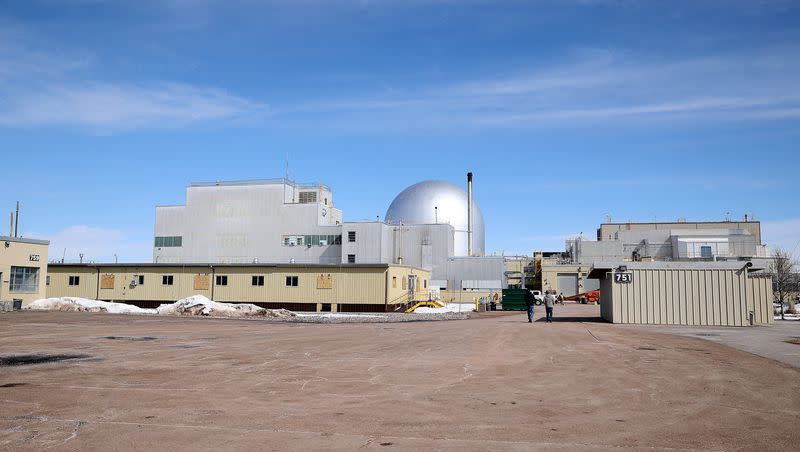A solution to Utah’s air quality problem? Heavy industrial plants

The idea of using heavy industry as a way to temper Utah’s air pollution problem seems to be in sharp conflict, but it is not outside the scope of a nuclear energy initiative led by the Idaho National Laboratory.
That is part of the Frontiers Collaboration, which includes the University of Utah teaming up with diverse partners that include the universities of Alaska, Wyoming and Michigan, Boise State University and the Massachusetts Institute of Technology.
With energy security and energy transition in mind, the collaboration seeks to command a stronger global presence for the country by zeroing in on low-emissions manufacturing in industrial processes via the deployment of nuclear reactor batteries.
The role of Utah: Steven E. Aumeier, senior adviser to strategic programs at the Idaho National Laboratory, said it is no accident that universities in Alaska, Idaho, Wyoming and Utah are part of Frontiers.
“The Frontier initiative is completely focused on the nuclear energy first mover states, which happen to be the states we’re talking about here: Idaho, Utah, Wyoming and Alaska,” he said. “How do we help those first mover states catalyze the right partnerships and the right approaches so they can leverage that first mover status to get a leadership position in global low emissions in manufacturing? And that is a hugely important thing.”
Aumeier said Alaska and these states in the West are leading in the space of changing energy landscapes. And Utah, he added, is particularly poised to be at the forefront for a couple of additional reasons.
“In this fabric of energy transitions, especially in the Intermountain West, Utah’s key, right? I mean, you have energy transitions in their own right, but Utah’s really a leader in manufacturing and finance, and we think they’re going to play a big role and can play an even bigger role when they collaborate with Wyoming, Alaska and Idaho to look at energy futures.”
Global energy transitions and EMA: The University of Utah is also part of Idaho National Laboratory’s Emerging Energy Markets Analysis Initiative that emphasizes clean energy innovation appropriate for a particular location, can be brought to scale so it is economically attractive and is sustainable and resilient, among other things. EMA, as it is called, is pushing the acceleration to clean energy.
Globally, the initiative points to examples that already exist in these market shifts. Citing research institutions and media reports, the initiative pointed to these examples:
In South Africa and Nigeria, mobile phones are as common as in the United States.
There are places where there’s still no running water, but people can stream a video.
In the countryside, there has been a rapid spread of pay-as-you-go solar-generated power in which customers buy electricity with mobile money for as little as 50 cents a day.
Aumeier said EMA seeks to find community-based solutions in the universe of energy transition that are site-specific to that area’s characteristics.
“A lot of time you see really smart engineers and economists doing studies on solar and nuclear and fossil and all this stuff, and it’s really just an incomplete view, many times, at least in our assessment,” he said.
That initiative, or EMA, brings together a diverse group of professionals that include engineers, attorneys, energy experts, academia, economists, policy influencers and more.
“Over the years there’s been a lot of debate with people focusing on what technology should be used, the cost of that technology versus another,” he said. “We said, going forward that’s really not the question to ask. The question to ask is what’s most valuable for a given community. ... Let people look at this through a different lens.”
Nuclear innovation, initiatives and change: The Idaho National Laboratory is the nation’s premier U.S. Department of Energy’s research and demonstration facility in the arena of nuclear power, hosting more than 50 nuclear reactors over the course of its history.
In addition, it is a partner in the planned NuScale SMR plant slated to serve many Utah communities when the Carbon Free Power Project comes online in 2030. The laboratory is also providing strategic guidance for the Natrium sodium fast reactor in Kemmerer, Wyoming, under development.
Related
Is next generation nuclear technology destined to serve Utah?
Retiring coal-fired power plants need a replacement. These Western states may have the answer
Why Utahns should care about mysteries unlocked at Idaho nuclear research facility
Utah, Aumeier said, is key in the space of energy innovation.
“We want to help Utah jump out in front and lead in this, in what I really see is a new economic frontier. That’s why we call that the Frontiers initiative. It’s about the frontier of economic competition. And we want to see these states lead because that helps the country. EMA is a part of that.”

